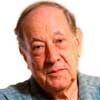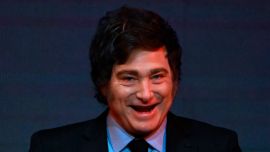Michael Soltys’ column in the Times on September 16, celebrating the 141st anniversary of the Buenos Aires Herald with an affectionate look back at the four decades he worked on the newspaper, prompted an interesting email from an old Herald hand.
Charles Sherman, who is now the editor-in-chief of the international edition of the Miami Herald, after a splendid career in the United States and Europe, sent this message to Michael:
“Allow this pat on the back for your finely turned remembrance of the Buenos Aires Herald and some of the stalwarts who once inhabited the paper. I would have been happy to read much more.
“Cox was the editor and my mentor in that weird time characterised by Isabelita and Lopez Rega. Andrew [Graham- Yooll] was the chief reporter. On an Inter-American Press Association grant funded by the Knights [John S. and James L. Knight of Knight-Ridder Newspapers], I worked as the news editor for a bit over a year. The inflation rate was three percent a day; bombs were going off in downtown trashcans and the Montoneros were grabbing people and anything else they could. The Malvinas were heating up. Newsmen were being executed in the fields around Ezeiza. Fortunately perhaps, the reports I wrote on the grim life of the country appeared mostly overseas.”
That voice from the past set me thinking about the years 1974 to 1976 that Charles spent at the Herald, which then had its offices on the corner of 25 de Mayo and Tucumán, in the same building as the long-gone English Club. In a broad stroke Charles had captured the salient features of life in Buenos Aires before the March 24, 1976, coup.
The power behind president Isabel Martínez de Perón, (the “Isabelita” in question, Juan Domingo Peron’s widow) was José López Rega, a former Federal Police corporal who dabbled in the occult. For, example he believed that he was the reincarnation of the Archangel Gabriel and claimed that he possessed supernatural powers. He was known as El Brujo, ‘The Warlock.’ But there was a far more sinister side to him too. He formed a murderous organisation called the Triple A (the initials of the Argentine Anti-Communist Alliance) to threaten and kill people he considered to be his enemies. His power stemmed from his influence over the late president Perón and his domination of Isabelita, who relied upon him totally.
At the time, the madness of López Rega and the mental fragility of Isabelita were not reported in the press. I managed to write about this weird ménage for The Economist and the news eventually trickled out in Buenos Aires.
It was a strange time. Hyperinflation resulted in frenzied minute-by-minute mark-ups in supermarkets, which led to fights between clerks and customers over what price to pay. Then there were the terrorist bombings, the kidnappings for ransom, aggressive nationalism focused on the Argentine claim to the Falkland (Malvinas) Islands. Journalists were being killed and their tortured bodies were left in ditches to encourage their colleagues to keep quiet.
Charles Sherman’s flashback to the days before the March 23, 1976 coup reminded me that – while the role played by the Herald during the 1976-83 dictatorship is now fairly well known – the newspaper’s stand during the violence that tore the country apart in the 1970s has not received anywhere near as much attention.
I remember discussing the daily horror with Andrew Graham-Yooll. We were trapped between the two sides in an underground civil war between recognisable armed groups on the left and shadowy forces on the right. The insurgency from the left was dominated by the fascist Montoneros and the Marxist-Leninist ERP (People’s Revolutionary Army), but I remember that in the early 1970s I once counted 35 different guerrilla groups, most of which eventually merged into the Montoneros or the ERP.
Andrew was keeping track of the murders in our ‘Black Book,’ a name drawn from its shiny black cover. In an attempt to raise the alarm about what was going to end in a Greek tragedy we decided to publish the daily death toll in a box on the front page. The other media outlets initially played down the carnage. The Herald did not. But significantly, as it became clear that, once again, a solution would be sought through a military takeover, the coverage became intense and the front pages of the newspapers became almost unbearable to read due to the concentration of the violence.
Earlier, when the Herald had moved from 25 de Mayo to its custom-designed offices and printing-plant at Azopardo 455, we were attacked by a heavily armed group of leather-jacketed thugs and a rotund policeman who had been added to the group to give the raid legal cover. We survived by being super cool. The jefe told me that they wanted to question Andrew. Surreptitiously, I managed to call him by phone and he came in. My wife had also joined us with some of her friends and a reporter from La Prensa. Then Andrew and I had a ride together to federal police headquarters where I heard, for the first time, the screams of people being tortured. It was all eventually sorted out, but Andrew, his wife and their family wisely decided to go into exile. Andrew learned from el jefe in a chance re-encounter years later that he had been targeted as a boleta (someone to be murdered).
I received a death threat from the Montoneros. “When we are victorious, you will be one of the first to be executed,” I was informed via a neatly typed note using the Montoneros letterhead that featured crossed automatic rifles. About the same time the Montoneros took exception to a sexual llusion to Evita Perón in an article by V.S. Naipaul that we published – somewhat daringly, I admit. They were said to have had a meeting to decide whether to plant a bomb inside Andrew’s desk that would explode when he opened it, but reportedly decided against it.
I confess that I am still trying to work out why Argentina was plunged into the violence of the 1960s, 1970s and 1980s. I do know that this blessed yet tortured country is still suffering from the wounds of those years. But I did suddenly realise that I do know why Argentina became an inferno.
When I realised that the coup was in the advanced planning stage I went to see one of the circle of civilians who were advising the military. He told me, rightly, that it was necessary to bring terrorist violence to an end. Then he said that it was a simple matter, all the “terrorists” would be eliminated as if they were stones to be thrown into a bottomless well. I was horrified by the suggestion and stuttered my remonstrances. “It is the only way,” he responded.
Even years after the return of democracy, those same civilians who had encouraged the military to destroy the rule of law were still defending that genocidal solution on the grounds that “it was necessary.”

























Comments